Understanding the Stage Persona - William Branham
In the height of William Branham's popularity during the Post WWII Healing Revival, William Branham changed his public image to that of a Baptist minister who accidentally stumbled onto Pentecostalism. This version of his image is a fundamental part of his "Life Story" recordings, and as a result, is fundamental to his "Message" cult following. If that story is removed, then all "supernatural experiences", doctrines, and events in his life related to his Baptist back story are then also removed.
In these versions of William Branham's stage persona, Branham claimed to have never heard of Pentecostalism in his early years as a "Baptist" minister. On a vacation without his wife to Lake Paw Paw, Branham allegedly stumbled onto a Pentecostal revival in Mishawaka, IN, just outside of South Bend where oddly, he was asked to speak. When he returned, he tried to convince his wife to join the Pentecostal movement, but his mother-in-law allegedly would not permit her daughter to get involved. Branham allegedly obeyed his mother-in-law, which he claimed to have resulted in his wife and daughter being killed by God during the Ohio River Great Flood of 1937. The deaths of his wife and daughter allegedly shook him enough to convert, and the stories built upon that foundation continue throughout his public ministry as a revivalist and later central figure of his cult of personality. The problem? The "personality" was the work of fiction, not an act of God. In of itself, this seems insignificant. Whether William Branham was Baptist or Pentecostal before becoming what he claimed to be "The Messenger For [The Previous] Age" should not matter, if in fact, he was this "Messenger" and the events he predicted to happen in the 20th Century or before 1977 came to pass. Though it may seem trivial on the surface, however, some of them raise very serious questions as to intent and honesty about certain events that he claimed to be supernatural. When considering the different and conflicting views on the Godhead when speaking to different audiences, they present an even bigger question: Was William Branham even a Christian?
After William Joseph Simmons was ousted from the 1915 Ku Klux Klan, Roy E. Davis was also out. Davis was a Baptist minister and evangelist from Texas, who was Simmons' official spokespersons until publicly exposed in a bigamous relationship and ultimately imprisoned for bank forgery. For a period of time, Davis lived in Louisville, KY, across the river from Branham's hometown of Jeffersonville. Many of his crimes caught up with him, including sexual crimes with underaged females, and for a period of time, Davis posed as a Pentecostal in Jeffersonville. By causing a local church to revolt against their pastor, Davis caused a church to split and started the "Pentecostal Baptist Church", which Davis said was a Pentecostal Assembly. William Branham's first wife, Hope Brumbach, was a leading member of the church, and Roy Davis baptized William Branham and ordained him as a minister in that Pentecostal Assembly. When Roy Davis was extradited to Arkansas and ultimately Texas for his crimes, William Branham assumed ownership of that Pentecostal Assembly. The original church burned to the ground, after which William Branham opened the "Billie Branham Pentecostal Tabernacle". Newspaper advertisements, government documents, and the city directories record Branham's history as a Pentecostal minister long before the timeline given in the "Life Story" accounts recorded in later years. The deed to his Pentecostal Tabernacle was 1936, but according to Branham, his church was dedicated in 1933. His date does not appear to be accurate, but in either case, both William Branham and Hope Brumbach were aware of Pentecostalism and leaders in a Pentecostal Assembly before the 1937 Flood. Hope did tragically die as Branham claimed, several months after the floodwaters subsided.
Researchers studying the history that William Branham gave in these accounts have labeled Branham a "Oneness Pentecostal", meaning that Branham rejected the Trinitarian doctrine of Father, Son, and Holy Spirit as One God. And rightfully so -- this is what William Branham claimed, and in most cases preached. According to Branham's doomsday theology, church members who accepted the Trinitarian doctrine were apostates, and that the "Persons" in the Godhead came from Satan himself. Like most Christians, this understanding of God is a life-or-death decision. Oneness Pentecostals believe that Trinitarians have accepted a "false god" and vice versa. Unfortunately, history has been written based on Branham's stage persona, and not according to his actual history. Before specific audiences, William Branham preached the Trinitarian doctrine. In 1952 in Hammond, IN, Branham said that Jesus was the Third Person of the Trinity, and had been yesterday, today, and forever:
Now, if Jesus Christ is the same yesterday, today, and forever, "A little while, and the world seeth Me no more, yet you'll see Me, for I will be with you even in you." Then Jesus Christ comes into His Church, to His people, to manifest Himself out through the people, while He, Himself, is setting at the right hand of the Father, sending back the Holy Spirit, the Third Person of the Trinity, to live in human beings, to work through them, to show the same works that He did in the beginning, making Him, "the same yesterday, today, and forever."
In Erie, PA, Branham prayed to the Trinitarian God and asked "the Holy Spirit, the Third Person of the Trinity" to visit the audience. In New York, Branham included himself in "we who've accepted the Holy Spirit, the Third Person of the Trinity." Across the river from his hometown of Jeffersonville in Louisville, KY, Branham spoke individually to the Father and the Holy Spirit when he said, "Now, Father, take the Word, and may the Holy Spirit, the Third Person of the Trinity, comes, take the Word of God, and break It out to the people". At times, even in his hometown of Jeffersonville, Branham asked "the Holy Spirit, the Third Person of the Trinity, [to] come, take the Word of God, and place It into every heart." Understanding William Branham's usage of stage personas is very critical to both leaving his "Message" personality cult and understanding it. Not only was his Baptist persona fundamental to the cult, each and everything that he associated with that persona is just as fundamental. Some core doctrines, such as either his rejection or accepting the Persons in the Trinity, are tied to that fictional persona. And for a Christian, issues as significant as whether God is non-Trinitarian or Trinitarian are mutually exclusive -- if you are a Christian, you are either one or the other. If you are a Christian minister, you cannot be both.
-
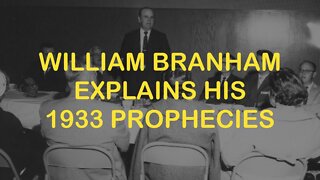 6:14
6:14
William Branham Historical Research
1 year agoWilliam Branham Explains His 1933 Prophecies
16 -
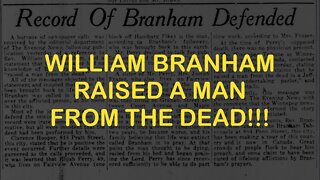 3:31
3:31
William Branham Historical Research
1 year agoRaised from the Dead by William Branham!
40 -
 4:43
4:43
wmbhr
1 year agoWilliam Branham was a Leader in the UPC ... Explained!!!
2 -
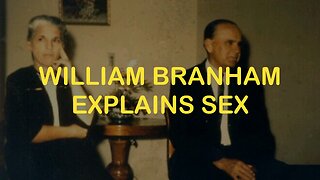 4:41
4:41
William Branham Historical Research
1 year agoWilliam Branham Explains Sex
46 -
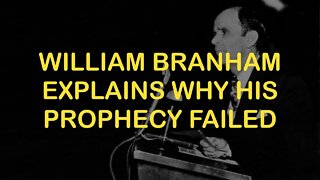 5:23
5:23
William Branham Historical Research
1 year agoWilliam Branham Explains Why His Prophecy Failed
22 -
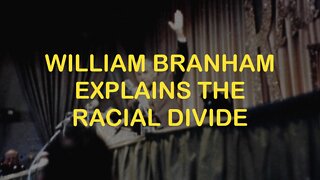 5:22
5:22
William Branham Historical Research
1 year agoWilliam Branham Explains the Racial Divide
39 -
 1:56
1:56
William Branham Historical Research
1 year agoWilliam Branham and FLDS
67 -
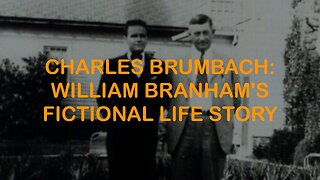 2:45
2:45
William Branham Historical Research
1 year agoCharles Brumbach: William Branham's Fictional Life Story
62 -
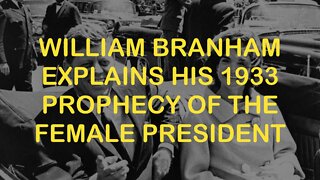 5:01
5:01
William Branham Historical Research
1 year agoWilliam Branham Explains His 1933 Prophecy of the Female President
69 -
 1:31:42
1:31:42
William Branham Historical Research
9 months agoWilliam Branham and the Imperial Wizard
30